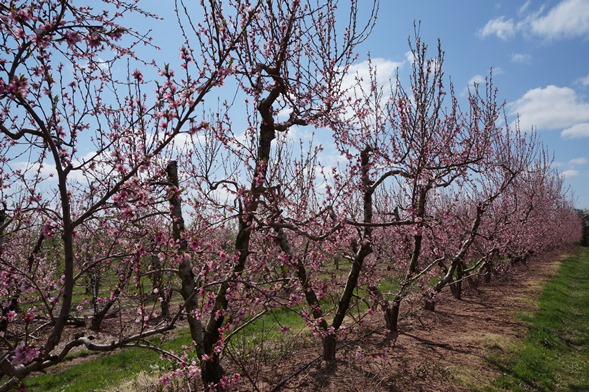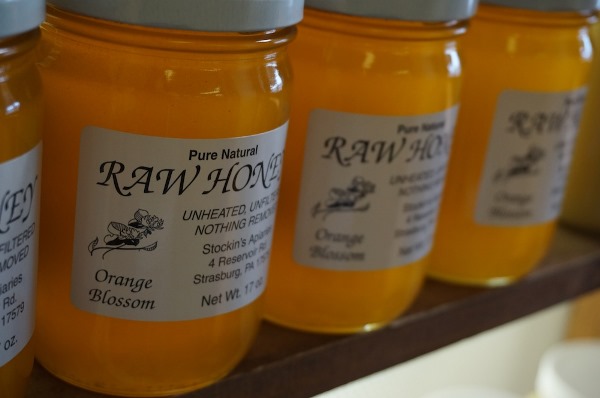
“I could talk for hours about honey bees,” says Gary Stockin, who owns Stockin’s Apiaries in Strasburg, PA and supplies Weaver’s Orchard not only with honey, but also with bees that pollinate the fruit trees. Gary Stockin enjoys looking at the brood—seeing the eggs and larvae develop into full-grown bees—and watching the adult honey bees work. Stockin sees the creation of God whenever he looks into a hive.
“Bees have to know so much to survive,” he says, listing off what these half-inch long insects know how to do: how to communicate, how to navigate directions as they forage, and how to test temperatures. The fact that honey bees pack all of their expertise into only 60 days of life amazes Stockin. In that short lifespan, honey bees complete an array of complex tasks. They manage hive housekeeping for 30 days and then spend 30 days traveling, foraging pollen from flowers and plants and bringing it back to the hive. To forage, bees travel “only as far as they need to,” says Stockin, estimating that his bees usually travel within a mile to mile-and-a-half radius.
These intrepid and industrious creatures have fascinated Gary Stockin ever since he was a child. He grew up on a dairy farm and then spent thirteen years breeding cows. Then a retired beekeeper from his church gave him beekeeping equipment and a vision for beekeeping as a way to earn a living. Stockin had always hoped that he could devote himself to beekeeping full time, and now he began to glimpse this possibility. Soon, Stockin advertised a unique service in the local newspaper: if people had unwanted bees in their houses, he would come get them. These honey bees launched his apiary. Shortly after that, Stockin received even more hives, this time from a local farmer in his eighties who had raised bees on his orchard.
Now Gary Stockin has over 100 hives. In summer, when bees begin to produce honey, that number often grows to about 300. Although by this spring he was down to 70 hives, Stockin says that the hives are now on the upswing and look good. “Beekeepers are always optimistic about the next year,” he says.
While the upcoming year looks good, beekeepers have been having a rough couple of years with their bees. “No one,” says Stockin, “can put a finger on exactly what it is.” Stockin suspects that what has been afflicting his hives is a combination of new methods of crop production and mite problems. Mites carry diseases and viruses and are a common problem known to apiaries.
With the popularity of documentaries like Vanishing of the Bees (2009), Queen of the Sun (2010) and the PBS Nature special “The Silence of the Bees” (2007), many people have become concerned about honey bee populations. Stockin suggests several things that the average person can do to keep honey bees safe. Be careful about spraying pesticides in your garden—especially on or near clover and dandelions, and even more so if you see honey bees working. He also suggests choosing non-GMO produce whenever possible, and selecting fruit from orchards and melon-producers that are careful where and when they spray, especially since pesticides can drift.
“Weaver’s is always very careful and cautious,” says Stockin, who stops by regularly to check on the hives he manages here. Weaver’s takes many measures to protect honey bees because honey bees are so valuable to our crops. Honey bees pollinate fruit, transferring pollen grains from the site where they are produced (the “anther”) to the site where they germinate (the “stigma”). Honey bees are unique pollinators because, unlike many other pollinators, honey bees actually want the pollen—not just the nectar—so they can give their developing larvae a protein boost. Pollen sticks to the bees’ fuzzy bodies, and when they rub some of it off, it pollinates flowers.
Recently, Weaver’s started to introduce Stockin’s bees to cherry pollen, to “give them a taste for cherries” and help pollinate this crop.
These energetic pollinators bring us sweet, juicy fruit and—of course—sweet, healthy honey. This time of year, many people seek out local honey for relief from seasonal allergies. Stockin keeps a long mental list of local honey’s health benefits, and likens raw honey to raw vegetables because of the enzymes active in raw honey. Noting that many grocery store honey varieties are changed to provide a long shelf life, he says, “You can make honey worse, but you can’t make it better.” It’s delicious just as it is, fresh from the comb.
Among its benefits, honey enters the system more slowly than sugar, so it sweetens without giving you a sugar rush or the inevitable crash afterwards. It helps people sleep, soothes burns and cuts and kills bacteria.
Since there are so many different kinds of honey, you can try different flavors as you supplement your health—from zingy basswood honey to mild clover and alfalfa honey to very fruity orange blossom honey. The strongest honey Stockin sells is buckwheat honey, which is rich in antioxidants. The darker the honey, the richer it is in antioxidants, Stockin explains.
At Weaver’s, you can purchase Stockin’s honey and watch a hive in action, and kids can hear more about honey bees on our school tours. If you watch the hive long enough, these creatures might stir up an interest akin to Gary Stockin’s. Before you know it, you’ll want to talk about these fascinating insects for hours, too.
* * *
Article written by Rebecca Talbot and coordinated by VanDuzer Design & Marketing for Weaver’s Orchard and may also be syndicated on Fig: West Chester and Rachel’s Farm Table.


